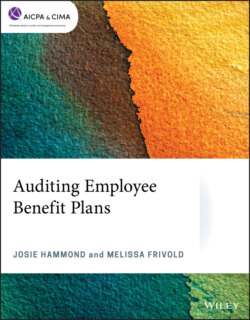Читать книгу Auditing Employee Benefit Plans - Josie Hammond - Страница 32
Nondiscrimination
ОглавлениеThese rules apply to both the formation of the plan and the annual operations. There are a variety of rules that all relate to providing that a broad cross-section of employees can participate in the plan. Again, pension plans have more rigorous standards than welfare plans. (Remember, in this area we are using the GAAP concepts of “pension” versus “welfare” plans. Some compliance tests are limited to a certain type of “pension” plan. Where this is the case, the type of plan will be mentioned.) This course will not cover the new discrimination standards for health plans under the ACA, as the implementation of these standards has been deferred.10
Coverage. For a defined benefit pension plan to be qualified, it must cover at least 40 percent of the eligible workforce, or 50 people.
Participation. For any pension plan to be qualified, one of two standards must be satisfied:
1 The number of participating, eligible non-highly compensated employees must be at least 70 percent of the percentage of the participating highly compensated, eligible employees.
2 The average benefit provided to eligible non-highly compensated employees must be at least 70 percent of the average benefit of the eligible highly compensated employees.
As noted previously, eligible employees are those who have satisfied the plan’s age and service standards. This participant standard only applies to the employer contribution in a 403(b) plan. Employee salary deferral privileges in a 403(b) plan are subject to “universal availability,” which permits very few exclusions from eligibility.
Nondiscrimination in contributions, vesting, or other plan features. The plan features available to highly compensated employees must, generally, be available to other participants.
Average Deferral Percentage (ADP) and Average Contribution Percentage (ACP). Special tests apply to plans that permit employee contributions. 401(k) plans are subject to both of these tests. 403(b) plans are only subject to the ACP test.
Eligible compensation. Because most benefits are based upon compensation, the definition of compensation used must also be nondiscriminatory. In addition, the amount of compensation that can be recognized for any participant is limited by law. For 2014 and 2015, no more than $260,000 and 265,000, respectively can be counted in determining benefits. A list of the benefit limits for various years can be found at www.irs.gov/Retirement-Plans/COLA-Increases-for-Dollar-Limitations-on-Benefits-and-Contributions.
Other rules. Top-heavy and safe harbor plans have minimum required contributions.
403(b) plans are subject to the preceding standards with respect to employer contributions, except the top-heavy rules do not apply. Employee salary deferrals or Roth contributions are subject to the annual dollar limits of a 401(k) plan, including the catch-up amounts, but are not subject to the ADP test. In addition, there is a special expanded contribution limit for long-service participants in a 403(b) plan. Most violations for a 403(b) plan only go to the tax status of the benefits for the affected participant. Violations of the written plan document requirement or universal availability can jeopardize the tax status of the entire plan.
Welfare plans, currently, have separate, less rigorous standards. Typically, the violation of the nondiscrimination rules for welfare plans does not affect the plan’s operation. They only affect the tax status of the benefit received by the participant and, potentially, a penalty to be imposed on the plan sponsor.
For more information on the compliance rules applicable to retirement plans, the auditor may wish to review the IRS webpage at www.irs.gov/Retirement-Plans/A-Guide-to-Common-Qualified-Plan-Requirements.
All qualified pension plans and 403(b) plans are subject to funding. This means that assets must be set aside to cover such benefits. Contributions to defined benefit pension plans are made throughout the year. Money purchase pension contributions are due no later than 8½ months following the end of the plan year. Discretionary plans, such as 401(k) plans or profit sharing plans, are not required to receive contributions every year, but the IRS rules require periodic and significant contributions to retain tax-qualified status.
Defined benefit retirement plans are to have obtained a certification of funded status not later than September 30th of each year. This is necessary because the PPA limited certain plan actions based upon the plan’s funded status.11 Some relief on the required funding of defined benefit plans was granted by the Worker, Retiree, and Employer Recovery Act of 2008 and the Preservation of Access to Care for Medicare Beneficiaries and Pension Relief Act of 2010 and in Moving Ahead for Progress in the 21st Century Act (MAP–21) in 2012. All of this activity means that it is important for auditors of defined benefit plans to stay up to date on developments, watch for plan amendments and pay close attention to the work done by the actuary.
Neither the tax nor the ERISA rules require that welfare plans be funded, but it is not uncommon to see plan document provisions requiring some level of funding.
